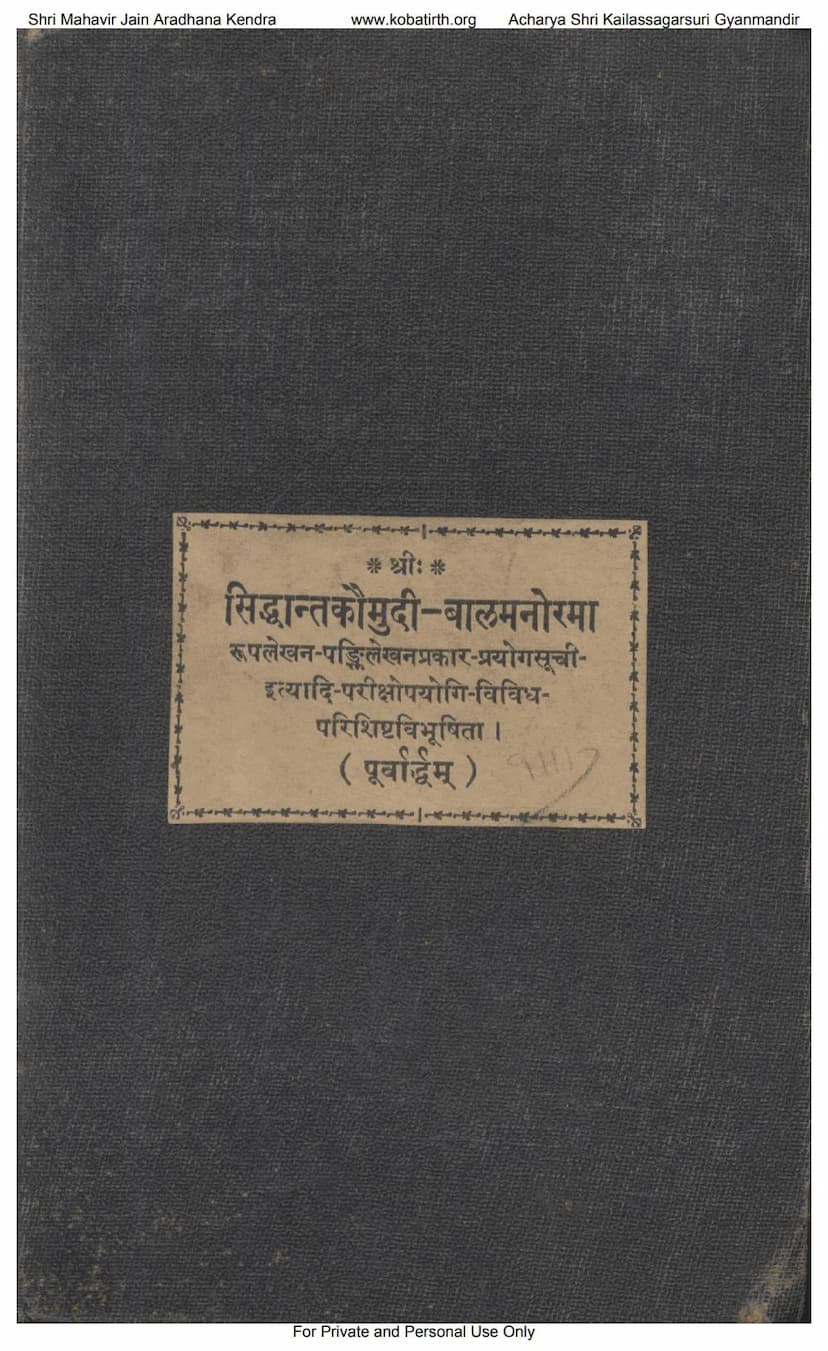Siddhanta Kaumudi Bal Manorama
Added to library: September 2, 2025

Summary
The book "Siddhanta Kaumudi Bal Manorama" (Part I), authored by Gopal Shastri Nene and Sadashiv Shastri Joshi and published by Jaykrishnadas Haridas Gupta in 1941, is a commentary on the renowned Sanskrit grammar text "Siddhanta Kaumudi" by Bhattoji Dikshita. The commentary itself, "Bal Manorama," was composed by Vashudeva Dikshita.
This particular volume (Part I) of the Siddhanta Kaumudi with the Bal Manorama commentary serves as a comprehensive guide to Sanskrit grammar, specifically focusing on the Pāṇinian system. It adheres to the structure and principles established by the great grammarians Pāṇini, Katyāyana, and Patanjali, often referred to as the "Trimuni."
Key aspects and content covered in this volume include:
- Foundation of Sanskrit Grammar: The text begins by acknowledging the lineage of Sanskrit grammar, tracing its roots to Pāṇini's rigorous penance and the blessings of Lord Shiva. It highlights the purpose of grammar as understanding and preserving the Vedic language.
- The Maheswara Sutras (Pivotal Sound System): The book meticulously details the fourteen Maheswara Sutras (also known as Shiva Sutras), which form the foundational phonetic and morphological framework of Pāṇinian grammar. The commentary explains how these sutras are instrumental in forming the pratyāhāras (sound groups) that are crucial for understanding the grammatical rules.
- Introduction to Grammatical Terminology (Samjña Prakaraṇa): The initial section is dedicated to explaining fundamental grammatical terms and their definitions (saṁjñā). This includes concepts like it-saṁjñā (the technical term for letters that are dropped), halantyam (indicating final 'h' and other consonants that become 'it'), ādiraṇtyena sahetā (the rule for forming pratyāhāras), uṇādi saṁjñā (related to the maheswara sutras), and the classification of vowels based on their duration (hrasva, dīrgha, pluta) and accentuation (udātta, anudātta, svarita). It also covers the concept of savarṇa (similar sounds) and the rules governing them.
- Sandhi (Phonetic Combination): The book delves into the rules of sandhi, which govern the euphonic changes that occur when words or sounds are combined. It covers both vowel sandhi (ach sandhi) and consonant sandhi (hal sandhi), explaining principles like vowel substitution (yaṇ sandhi), mergers (guṇa and vṛddhi), assimilation, and other phonetic modifications.
- Additional Appendices: The volume includes valuable appendices designed for examination purposes, such as:
- Rupa-Lekhanaprakara (Methods of describing forms)
- Pankti-Lekhanaprakara (Methods of writing in lines or sequences)
- Prayoga Suchi (List of examples and usages)
- Sūtra Suchi (List of grammatical rules/sutras)
- Vārtika Suchi (List of commentaries/amendments on sutras)
- Pariśiṣṭa (Appendices): This includes indices for the rules, grammatical roots, vārtikas, definitions, and even sample question papers, making it a practical study tool.
Commentary Style:
The "Bal Manorama" commentary is known for its clarity and comprehensiveness. It aims to simplify the complex rules of Pāṇinian grammar, making them accessible to students. The commentary provides detailed explanations, clarifies potential ambiguities, and offers numerous examples to illustrate the application of the rules. The editors, Pandit Gopal Shastri Nene and Pandit Sadashiv Shastri Joshi, have meticulously refined and supplemented the text with various indices and lists to aid students' understanding and preparation for examinations.
Significance:
This book is a significant contribution to the study of Sanskrit grammar, particularly for those seeking a deep understanding of the Pāṇinian system. The inclusion of detailed appendices and the clear explanations in the "Bal Manorama" commentary make it a valuable resource for students and scholars of Sanskrit language and linguistics. The publishers, Jaykrishnadas Haridas Gupta, have presented this work as part of the esteemed "Kashi Sanskrit Series."